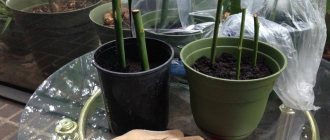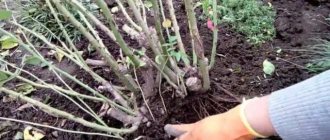Author: Elena N. https://floristics.info/ru/index.php?option=com_contact&view=contact&id=19 Category: Plant propagation Published: July 16, 2014Republished: February 16, 2019Last edits: April 15, 2021
- Propagation of roses by cuttings in a bag
Propagating roses by cuttings, despite its popularity and many methods, is not an easy task. There are many tips and methods (they root it in potatoes, in a bag, and in the cellar), but they do not always give results. Experts warn: the success of rooting roses from cuttings directly depends on what species the parent bush is. It has been noted that roses with small leaves, as well as rambler hybrids with long flexible branches, take root almost without fail.
- How to increase the chances of rooting the roses you like from a given bouquet or from a neighbor’s bush, when the variety is not really known?
- How to choose the ideal stem for cuttings?
- How to prepare a solution that stimulates root formation at home?
- How to root a cutting directly in the garden?
- Is it worth cutting exotic roses from a bouquet?
Read our material.
Is it possible to germinate a rose from a bouquet?
For propagation in this way, flower cuttings taken in early summer are most suitable. The best time is June. You can do this at the end of summer, but it will be more difficult to achieve results. It is most problematic to achieve the emergence of a root system and preserve seedlings until spring in autumn and winter. Rooting 30% of seedlings in winter and 70% in spring is an excellent result. In summer, the chances of roots appearing increase to 90%.
—
Which roses from the bouquet are suitable:
- not fully blossomed with a green semi-lignified stem without signs of rotting;
- with developed healthy buds in the leaf axils;
- with the lower part of the stem the diameter of a pencil.
Varietal roses with large buds on fatty shoots are almost impossible to root. Do not delay the process of growing seedlings. Proceed with it after receiving flowers: a wilted and faded plant very rarely takes root.
Rooting also depends on the type of flower. The following roses take root quite well:
- polyanthaceae;
- ground cover;
- small-flowered;
- miniature.
Climbing roses, fine roses, and grandifloras are the worst suited for obtaining seedlings. The probability of floribunda stems rooting is 50%. Park roses take root most poorly.
If the bouquet is made up of local varieties, then the emergence of the root system will occur quickly and without problems. When growing roots on flowers brought from abroad, the chances of successful rooting are only 40%. This is explained by the fact that plants are treated with hormones that inhibit the wilting process, but they also delay the process of root emergence.
Red and white roses have a higher degree of rooting, unlike yellowish and fawn roses
It may turn out that a cutting of an exquisite rose of an unusual shade will produce simple pink or yellow flowers. It is likely that the parent plant was a hybrid bred for certain properties. During vegetative propagation, daughter shoots rarely retain their selection qualities.
What is cutting?
Cuttings are one of the options for plant propagation. This is the most convenient way to grow flowers indoors. This is comparable to cloning the original variety. Using cuttings, you can quickly and inexpensively grow many plant specimens.
Important! The main advantage of cuttings is the preservation of all the features of the mother flower. This is important when growing valuable varieties.
Various types of cuttings are used to propagate the plant. They can be stem or leaf. The former are used for several types of plants. More common are leafy ones. They can be:
- whole with petioles;
- whole without petioles;
- fragments of sheets.
Cuttings are also divided into types according to location. Thus there are:
- apical;
- stem;
- basal.
As a rule, cuttings are taken from the lower part of the flower stem, starting from the middle. In some cases, the upper half with leaves is also used.
Optimal conditions for root emergence
The roots of rose seedlings appear after about a month. With any cutting method, it is important to maintain a temperature of about 20 degrees and high atmospheric humidity until this moment. Future roses should not be kept in bright sunlight to avoid burns. If they are in a greenhouse or greenhouse, ventilation is required in the morning and evening.
Use of growth stimulants
Soaking with a special biostimulator accelerates the appearance of roots. If it is purchased, you need to keep the stems for six hours.
Purchased products to stimulate root growth:
| Biostimulating drug | Correct proportions of solution (product/water) |
| "Kornevin" | 1 gram per liter |
| "Radifarm" | 2 drops per liter |
| "Heteroauxin" | 1 tablet per 2.5 liters |
| "Epin extra" | 1 ampoule per 2 liters |
| "Zircon" | 1 milliliter per 10 liters |
When using Radifarm, the soaking time is reduced to half an hour - the drug is very active. You can use traditional methods - an aqueous solution of aloe juice (9:1) or water with honey (dissolve a small spoon in 500 ml of water). Then the soaking process is extended up to 24 hours.
Stimulating growth
Experienced florists actively use special growth stimulants. Thanks to them, you can easily germinate even weak planting material, significantly increasing the chances of success. It is important that you can purchase them at almost any flower shop.
Now all that's left to do is wait
It is best to use root growth stimulants. This category includes special preparations such as “Ukorenitel”, “Kornevin”, as well as any others that contain heteroauxin - a stimulator of root formation. They can be used in liquid form (dilute in water and place the cutting there) or dry (pollinate the lower part of the future seedling).
However, you don’t have to go to the store and buy special stimulants to grow roses. It turns out that they can be made with your own hands - there is nothing complicated here.
The easiest way is to use regular honey. Dilute a teaspoon in a liter of warm water, then lower the cutting there for 12 hours. This will accelerate the development of the root system, strengthen the plant’s immunity and allow it to accumulate the nutrients necessary for growth.
You can also use aloe juice. It must be squeezed out of any leaf and added to warm, settled water at the rate of 6 drops per 200 grams.
Some experienced gardeners use regular baker's yeast to help cuttings grow roots. They are dissolved in warm water, where the cuttings are immersed for a day. After this, it is transplanted into ordinary water and the rapid development of the seedling is soon noticed.
Germinating roses from a bouquet in water: instructions
This method is simple and accessible. Its effectiveness depends on the quality of the water. If it is not of sufficient quality, the stems will rot. The most suitable is spring or melt. Tap water must be filtered and left to stand for 24 hours.
The most suitable water for roses is spring or melt water.
The step-by-step instructions here are simple:
- Pour water into the container so that the ends of the cuttings are submerged a quarter of the way.
- Place the stems in water.
- Place the jar in a slightly shaded place.
It is better to choose a container made of dark glass or plastic, but if this is not available, a regular three-liter bottle will do.
Water replacement is carried out every two days. After three to four weeks, whitish thickenings - calli - will appear at the bottom of the cuttings. Then the roots will “hatch”.
Video: rooting cuttings in water
Ways to develop the root system
If you decide to propagate roses yourself, then you need to know the ways in which you can properly cut the plant.
Some of these methods are often used the old fashioned way, while other methods are not familiar to everyone, but they help more effectively induce root growth and development.
But how to plant roses using cuttings from cuttings or a bouquet depends on what you like best.
So, what methods of planting cuttings can you choose:
- Germination in water;
- Growing in a pot;
- Germination in a bag;
- Rooting in potatoes;
- Burrito method.
It is also possible to use other growing methods, for example in a wet cloth, but their results will be worse, and many cuttings may not root.
Other germination methods
You can achieve the appearance of roots in other ways. Some gardeners believe they are even more efficient than using water.
In pots
For each future rose you will need a 500 ml pot and soil mixture. If it is purchased, it is better to choose one that is suitable for roses and violets. You can prepare the soil yourself - mix garden soil and sand in a 2:1 ratio and disinfect the resulting soil. When planting several cuttings in a large container, the step between them should be at least 6 cm.
The fact that roots have appeared will be indicated by soft green shoots on the stems
How to plant cuttings correctly:
- Wipe the inside of the pot with potassium permanganate to disinfect, place small pebbles on the bottom for drainage, then add soil.
- Dig a small hole, place the stem, fill and compact the soil, and water with settled water.
- Cover the potted seedling with a jar or plastic bottle, creating a mini-greenhouse.
When the surface of the soil begins to dry out, spray it with water from a spray bottle. The fact that roots have appeared will be indicated by soft green shoots on the stems. Then the roses begin to harden - adapt to the environment, periodically removing the coating for 5 minutes. This period gradually increases, and when leaves appear, flowers can be planted in open ground. If possible, they should also be accustomed to the street gradually, periodically placing pots on the balcony.
In the package
It is possible to create greenhouse conditions using an ordinary plastic bag without any pots. For this:
- Fill the bag one third full with a suitable soil mixture.
- Treat the bottom cut with a root growth enhancer and place in soil.
- Tie the bag so that the top is filled with air, and hang it near the window.
It is possible to create greenhouse conditions using a regular plastic bag without any pots
Green shoots will indicate the formation of roots. They will appear in two to three weeks. And replanting into the ground can be done after a month.
In the newspaper
This method is called the “burrito method”: the stems wrapped in newspaper look like a Mexican dish. How to cut roses this way:
- Spread the newspaper and place several prepared stems on it. Fold the edges at the cuts and wrap the rest of the paper around the cuttings so that there are no holes in it.
- Wet the resulting roll thoroughly.
- Place the bundle in a plastic bag, tie it and store at a temperature of about 20 degrees.
This method is called the "burrito method"
Unroll the roll once a week to check. If rot appears, the newspaper needs to be changed, leaving only healthy copies. After this, the bundle must be moistened abundantly again. The appearance of roots can be expected after two to three weeks.
Using potatoes
Using tubers to root cuttings is an effective and low-cost method. Future roses will receive the necessary nutrients and moisture for root formation from the tuber.
Using tubers to root cuttings is an effective and low-cost method
To create seedlings, you will need medium-sized potatoes, without signs of rot, wilting or damage. There should be no sprouts or green areas of the peel on them. The tubers must be thoroughly washed and treated with potassium permanganate for disinfection.
How to germinate a pink cutting in a potato:
- Cut a hole in the tuber that matches the diameter of the stem. The bottom of the recess should be about a centimeter thick.
- Treat the cut of the cutting with a biostimulant and place the stem in the hole.
- Fill a 500 ml container with soil one third of the way, put the potatoes in there and sprinkle with soil. Water it.
- Cover with a jar or plastic bottle to create a greenhouse effect.
Next you need to proceed as when growing seedlings in pots. But experienced gardeners say that rooting occurs faster - after two weeks.
Video: roses in potatoes
Rooting in winter in the ground, in a pot
Choose a pot with large drainage holes. Fill it with substrate. You can use universal soil, or one intended for violets, or sphagnum moss. Next, we make a hole into which most of the cutting can be deepened, with the expectation that the lower bud should be below ground level.
Dip the lower cut of the rose in Konevin, or Heteroauxin, immerse it in the soil, and sprinkle it.
To prevent stem rot, it is recommended:
- make a solution of Fitosporin and spill the soil;
- Place 1 tablet of Glyocladin in the pot.
Next, in the same way as in the previous version, we make the simplest plastic greenhouse.
Caring for sprouted cuttings before planting in open ground
If your cuttings have roots, but the buds have not bloomed, then the plant is still dormant. It is better to save them until planting in the garden - until late spring. They are kept in a cool place (temperature from minus four to plus two degrees). Then the seedling will “sleep” until spring.
But pink cuttings, when rooted, can immediately sprout. It is better to remove large ones immediately if planting is still far away. Otherwise, they will suck out all the nutrients and the seedling will die. Especially if you grew a seedling from a bouquet rose, say, in late summer or autumn.
For small sprouts, you can try to store the shoots in the refrigerator or cellar under constant supervision.
You can plant shoots with large sprouts in pots, but they will have to be hardened off, since until spring they will be in more comfortable conditions than outside.
When the cutting is completely ready for planting
After about a month or two, a whitish thickening - callus - forms at the bottom of the stem. It is the basis for the roots. When they reach a centimeter in length, the shoot can be planted in open soil or a pot (if it is not possible to keep it dormant until spring). When cuttings are taken in the ground, roots also appear at this time.
Listen to the article
Many gardeners have tried to grow roses from cuttings, but not all have achieved success. We will introduce you to several ways to grow roses from cuttings and hope that this knowledge will help you become more successful in breeding these truly royal flowers. Propagation of roses by cuttings gives a much more reliable result than grafting or seed propagation, due to its simplicity and the ability to carry it out at any time of the year, since not only spring shoots of a rose bush are suitable as cuttings, but also stems of roses from a bouquet given to you...
Planting a rooted cutting in a permanent place
Rooted cuttings, regardless of the technique used, are planted in open ground in late spring or early summer. Warm weather should be stable, without possible frosts. You can’t plant cuttings of roses in the fall - they will freeze.
Rooted cuttings, regardless of the technique used, are planted in open ground in late spring or early summer
For future roses, choose a sunny, windless area. How to plant them correctly:
- Loosen the soil and fertilize it with organic fertilizers.
- Leave at least three buds on the stems, and dig a hole slightly larger than the rhizome.
- Water the soil under the seedling and sprinkle with peat or sawdust.
- Create shade from direct sunlight.
Getting used to a new “place of residence” for roses lasts about 2 weeks.
You need to think in advance about covering young roses for the winter to protect them from frost. It depends on the variety. Some need to be dug up and kept cool. Others just need to be trimmed and covered with foliage.
With proper cuttings, planting and care, the former bouquet will turn into a real rose garden.
- Author: Olga Grow
Rate this article:
- 5
- 4
- 3
- 2
- 1
(9 votes, average: 3.1 out of 5)
Share with your friends!
General recommendations
The most suitable time for such an event: from the end of June to the end of July.
Preparing cuttings
Young and grassy shoots of roses are not suitable for cuttings at home. For this purpose, stems of the first year of life, 4-5 mm thick, which have not yet begun or have already finished flowering, are ideal. They contain more carbohydrates, which promotes better rooting of cuttings.
Rose cuttings are cut up to 25 cm long
When cutting a rose stem into cuttings (each 15-25 cm long), make sure that they have at least 3 buds. The lower cut is made oblique - at an angle of 450, directly under the kidney. And the top cut is made directly a little above the kidney. At the bottom cut, you can make another shallow longitudinal cut along the stem, two centimeters long. This will speed up the formation of roots.
Make a shallow cut along the bottom of the stem
Remember that as long as the cutting has no roots, its moisture supply will not be replenished. Therefore, it is important to preserve what you already have. In order to reduce evaporation, partial removal of leaves is carried out: the lower leaves are completely removed, and the upper ones are cut off by about a third.
To increase the percentage of successfully rooted cuttings, it would be good to soak the lower cut for 12 hours in some kind of liquid biostimulant for plants. Or you can simply dip it in a dry powdered biostimulator (such as Kornevin, etc.).
Slice treated with biostimulant











